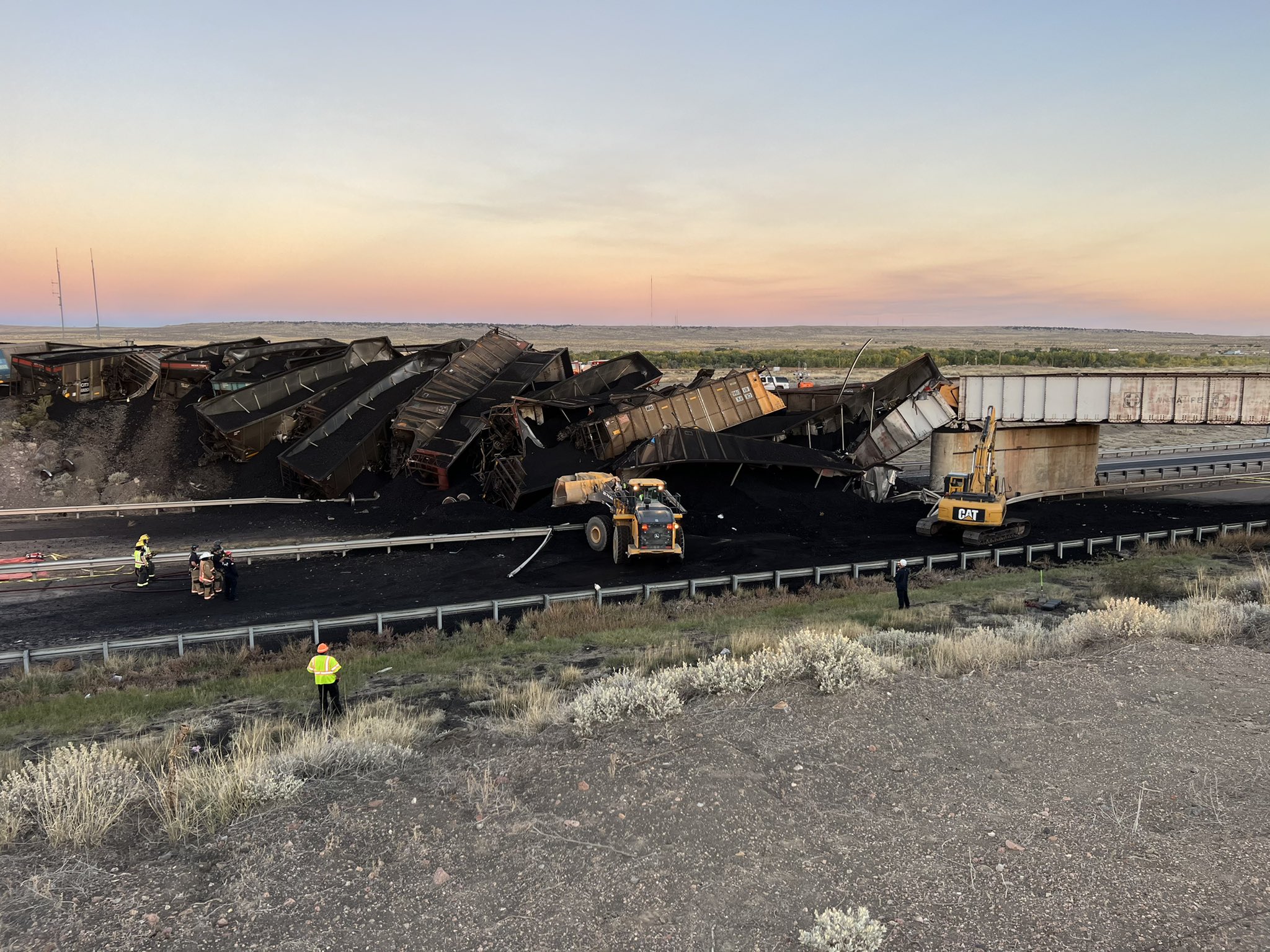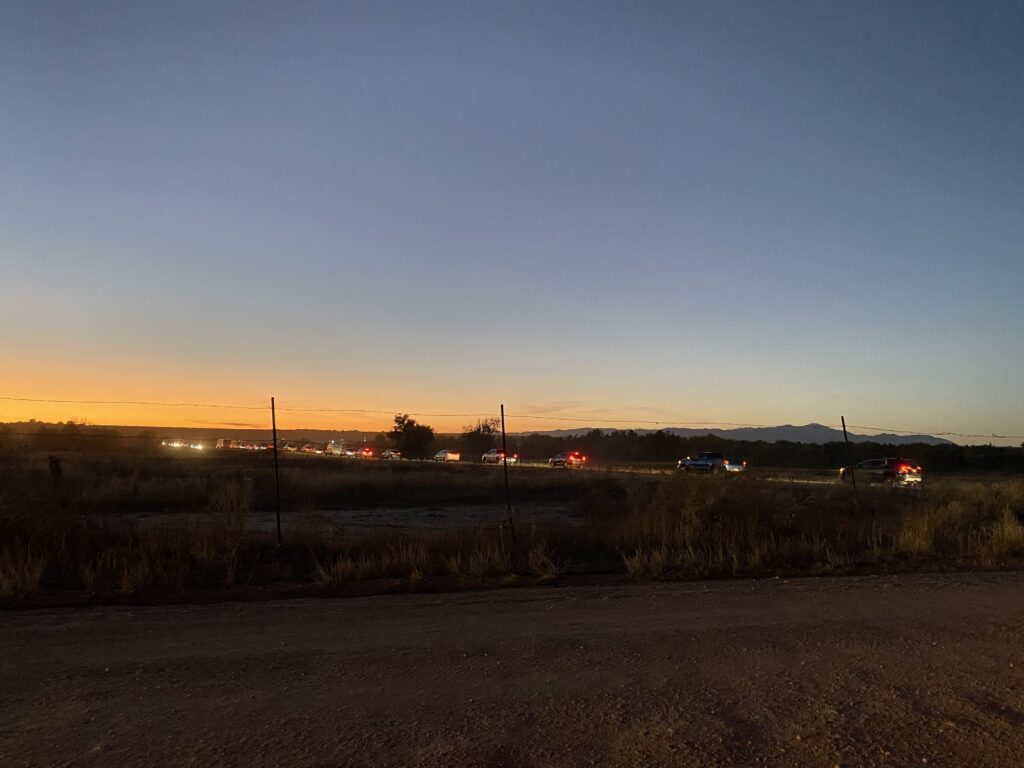
Updated at 7:18 p.m. on Oct. 17, 2023.
A broken rail likely caused 30 Burlington North Santa Fe Railway train cars to derail, and that preceded the collapse of a bridge over Interstate 25, just north of Pueblo. That’s according to a preliminary statement from the National Transportation Safety Board, the federal agency charged with determining what happened and why.
A semi-truck was crushed in the accident, killing the driver. No injuries were reported for the train crew.
“I am saddened that a life was lost in this train derailment and send my condolences to his family and loved ones," Gov. Jared Polis, who is scheduled to visit the crash site Wednesday morning, said in a statement. "Our immediate priority is safely getting the highway open both ways."
The Pueblo County Coroner's office has identified the truck driver as Lafollette Henderson, 60, of Compton, CA. He is survived by six children and 15 grandchildren, said his daughter, Endaya Jenel.
Every week, she said, Henderson would mail a toy car to Jenel's 16-month old son from around the country. Some of the mailings haven't been opened and she plans to save them until her son is older. She had a baby last week who the grandfather never met.
“I’ll never get another call from him while he’s on the road! Talking for hours on the phone at 5am. My heart is broken in more ways than one!” Jenel wrote in a social media post.
Five locomotives pulled the 124 car train. It remains unclear whether BNSF or the state owns the bridge that collapsed, and who held the responsibility to maintain it.
Federal investigators are expected to allow railroad crews to finish clearing the wrecked train cars and spilled coal soon. Then engineers from the Colorado Department of Transportation will evaluate what repairs are needed to reopen the interstate.
Traffic is being detoured between Pueblo and Colorado Springs. The primary route recommended by CDOT is via Highways 50 and 115 through Penrose, although oversize loads more than 11 feet wide need to take alternative routes.
Traffic local to Pueblo can take Overton Road and Jerry Murphy Road.
Broken rails and other track problems are a leading cause of derailments, according to federal accident data.
Investigators are working to determine the cause of the broken rail and why warning systems designed to alert the crew to the track condition failed. They’ll examine “the adequacy of track inspections, oversight of track maintenance, the bridge's structure and maintenance, and any issues with rail equipment,” according to an earlier statement from NTSB
The federal agency will issue its preliminary report within 30 days. The release of a final report can take one to two years.
The NTSB has long recommended that railroads install more automatic monitoring systems that can detect problems with tracks early on and prevent accidents. The agency repeated its call for those systems in July in response to a fatal Amtrak derailment along BNSF-owned tracks in northern Montana two years ago.

It was not immediately known whether the track where Sunday's derailment occurred had such a system. NTSB spokesperson Sarah Taylor Sulick said that was part of the investigation.
“They will be pulling maintenance records. They’ll be interviewing people involved. They’ll be talking to the railroad. They’ll be talking to the state,” Sulick said.
BNSF has not said when it last conducted an inspection and did not immediately respond to emailed questions or requests to view its inspection records.
Former NTSB investigator Russell Quimby said an automatic warning system likely was in place in Colorado because the accident happened along one of the railway's main routes between Denver and Texas, where BNSF is headquartered and which has numerous coal-burning power plants.
Those warning systems are integrated into the track and built so that if a rail breaks, they would stop any approaching trains, Quimby said. However, if the rail broke as the train was traveling over it, there would be little the engineer on board could do, since it can take over a mile to stop a fully loaded freight train, he said.
“The most stress you're going to have on that rail is when something's sitting on it. A fully loaded rail car, it's putting over 15 tons of pressure on the track per wheel," he said.
Railroads regularly inspect their tracks, looking for cracks or other defects in the rails that could make them more susceptible to breaking. Repairs are scheduled based on the severity of the defect, so even if a problem had been identified, it might not have been fixed immediately.
A nine-mile (14-kilometer) stretch of I-25 — used by 39,000 to 44,000 vehicles daily — was shut down. Traffic was being detoured around the derailment site and through the town of Penrose, almost 30 miles (48 kilometers) miles west of Pueblo.
Pressure for the railroad industry to improve safety has grown since a February derailment of a train hauling toxic chemicals that triggered evacuations in Ohio and Pennsylvania. There were more than 12,400 train derailments in the U.S. in the past decade, or more than 1,200 annually, according to Federal Railroad Administration data based on reports submitted by railroads.
At least 111 railroad accidents have been caused by bridge failures or bridge misalignments since 1976, according to an Associated Press review of derailment reports submitted by railroads to the Federal Railroad Administration. That’s just over two accidents annually on average.
Sunday’s accident follows a railroad bridge collapse in June along a Montana Rail Link route that sent railcars with oil products plunging into the Yellowstone River, spilling molten sulfur and up to 250 tons (226.7 metric tons) of hot asphalt. The accident remains under investigation.
AP Reporters Matthew Brown and Amy Beth Hanson contributed to this story.









